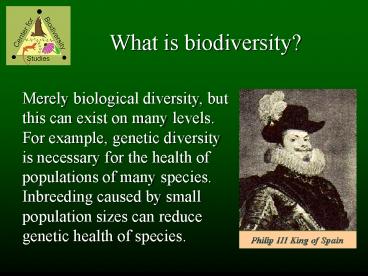What is biodiversity PowerPoint PPT Presentation
1 / 17
Title: What is biodiversity
1
What is biodiversity?
Merely biological diversity, but this can exist
on many levels. For example, genetic diversity
is necessary for the health of populations of
many species. Inbreeding caused by small
population sizes can reduce genetic health of
species.
2
Biodiversity is usually thought of as species
richness.
Species richness is the number of species in a
region.
3
Types of local species richness
Point richness is the number of species at a
given place. ? richness is the number of species
in a defined, continuous habitat ? richness is
the rate of change of species composition as you
move across habitats ? richness is the change of
richness across landscapes
4
Chronological species richness
In biological time local extinctions,
speciations, endemism and hot spots In
geological time Variety of evolutionary
explosions and extinctions
5
Measures of diversity go beyond simple richness
to include relative densities.
Shannon-Wiener index H -?pi ln(pi)
6
The rise of Western conservation thought
Romantic-Transcendental Conservation Ethic of
Emerson, Thoreau, and Muir--a noneconomic
aesthetic and religious movement Resource
Conservation Ethic--Gifford Pinchot--an
anthropocentric view that led to multiple use
concept of land management Evolutionary-Ecological
Land Ethic--Aldo Leopold--Equilibrium ecosystem
view--rise of ecology and evolution as
disciplines Modern Conservation Biology -- Soulé
and Ehrenfeld --provides a nonequilibrium,
synthetic view
7
Conservation Biology
Incorporates dynamic view of world Concentrates
on rare/endangered species, habitats,
ecosystems Is value-conscious Is
cross-disciplinary, even outside the biological
sciences Is a crisis discipline One of the most
rapidly-growing sciences
8
Value of Biodiversity
Instrumental GoodsFood, fuel, fiber,
medicine ServicesPollination, recycling,
nitrogen fixation, homeostatic regulation, early
warning InformationGenetic engineering, applied
biology, pure science Pycho-spiritualAesthetic
beauty, religious awe, scientific knowledge
9
Value of Biodiversity
Intrinsic Value is an inherent characteristic of
the thing. e.g. -- human life has value If
biodiversity--the existence of species--has
intrinsic value rather than merely instrumental
value, burden of proof shifts from conservation
to developer.
10
What is endangered?
A species is considered endangered if it is in
danger of extirpation and/or extinction
throughout all or a significant part of its
range. Extirpationextinction limited to a
specific geographic region Extinctiona species
disappears completely Rangethe geographic area
over which a species exists
11
What is threatened?
A species is likely to become endangered in the
foreseeable future throughout all or a
significant part of its range.
12
What is special concern?
A species that should be monitored because 1)It
exists in a limited geographic area 2)It may
become threatened or endangered due to loss of
habitat 3)It is vulnerable to specific pressures
due to biological constraints 4)Other identified
factors may jeopardize it 5)It is thought to be
rare or declining, but insufficient information
exists for assignment to threatened or endangered
categories.
13
Who maintains records?
Nationally, the US Fish and Wildlife
Service Within Kentucky, the state Natural
Heritage program is within the State Nature
Preserves Commission. They share responsibility
with KY Dept. of Fish and Wildlife Resources.
14
Why do species decline?
Natural processes (e.g. glacial cycles,
catastrophes, parasitism, disease) Anthropogeni
c processes Direct pressure (hunting,
extermination) Indirect pressure habitat
modification/destruction introduction of
disease/competitors removal of needed resources
15
Characteristics of sensitive species
Rare Long-lived Dependent on keystone
species Specialists Genetically
depauperate Environmentally sensitive
Poor competitors Valuable Occupy valuable
areas Dangerous Low repro rates Low survival
rates Prone to hybridization
16
Population viability analyses
Examine, predict future of a species, develop
SSP Ecology Demography Genetics Effective
population size Minimum viable population size
17
Answers
- Economics (ecotourism, natural products)
- Sustainable development
- Sustainable agriculture
- Indigenous action
- Policy and legislation
- Political pressure
- Social reform

